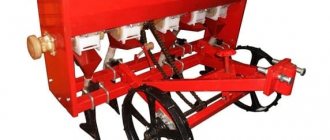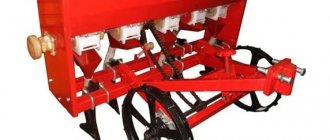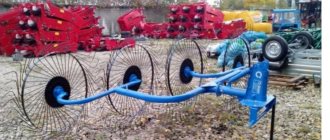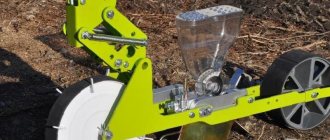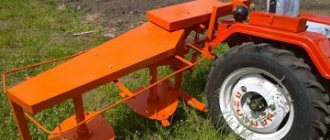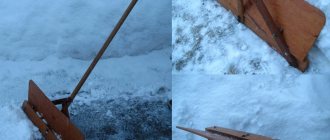Most farms are focused on growing their own fodder crops. However, feeding plant matter to livestock in its pure form is rarely practiced.
The best option is to use mixed feed, however, its production is impossible without the use of special equipment. It is not economically profitable to purchase combined feeds in ready-made form.
It’s much easier to smoke a feed chopper and set up your own production of combined mixtures. Doing this is not as difficult as it seems at first glance.
Do you need a shredder?
Undoubtedly, because grass is the basis of the diet for chickens, no matter how strange it may sound. For owls, for example, it is important to eat whole rodents, although they will regurgitate fur and bones. This is how their digestive system works. The same goes for chickens: they can be fed with special feed, grain, etc., but nothing can replace the nutrients that are in fresh living grass.
However, compared to owls, chickens need to eat the grass they need every day. How much human power is enough to cut plants by hand every day? Hardly a lot. This is why you need a herb grinder. Moreover, chopped plants are much more pleasant for the chicks: it is easier to peck at the ready-made food than to try to pick leaves from a long stem.
Also, a grass chopper for chickens will be useful if there are quite a lot of chickens themselves. Daily cutting of plants is depressing, and if you need to do it on a particularly large scale (after all, chickens eat a lot), then you cannot do without a suitable tool.
Design and principle of operation
Any device for grinding herbs works on the principle of a food processor: it cuts the entire contents into small pieces using sharp knives. There are different variations among grass cutter models, but their essence is always the same: grass is placed in a container, rotating blades grind the contents, and the finished product is discharged (due to centrifugal force) through a special hole on the side.
Any chicken grass chopper consists of several key parts :
1Container for storing raw materials
It is here that the unprocessed plants the chickens need are supplied. The amount of initial material that can be placed in the container depends on the technical characteristics of each individual model.
Although, often, to feed a small number of chickens, skilled poultry farmers create such devices themselves. In this case, the most common 12-15 liter bucket is used as a container for laying grass. It can also be replaced with a plastic barrel or other more suitable containers.
2Knives
Knives are installed in the lower part of the mentioned container for raw materials. Some models may use cords (trimmer lines). For feeding chickens, this method of cutting grass is even preferable: the pieces of plants will be larger, and it will be more convenient for the birds to peck at them.
And when using models with sharpened knives, there is a high probability of obtaining mulch (for gardening) or even grass porridge. Neither one nor the other is suitable for feeding chickens - they will refuse to eat it.
3Engine
Grass cutters can be either automatic (most often) or manual. Purchased models have a variety of engines depending on the goals pursued. This also affects the power of the device. Particularly productive shredders, in addition to cutting the grass too finely, can additionally create a lot of dust.
To avoid this, manufacturers install different filters on grass cutters, but what if the grass is cut to feed chickens? It does not require a high-performance and powerful engine, which means it will not really create dust.
Homemade models can even use drills or angle grinders (angle grinders), at the end of which there will be blades for grinding grass. In some special cases, grass grinders for chickens are also made from old unwanted washing machines.
Their main principle of operation ideally meets the requirements of grass cutters: blades are installed in the drum, an additional hole is created for the output of chopped grass, after which the device begins to work for its intended purpose.
4Other details
In addition to the raw material container, blades and motor, a variety of additional accessories can be installed:
- protective casing;
- wheels (allow the chopper to be moved freely around the area);
- cable for connecting the unit to the electrical network;
- sieve;
- filters;
- blowing the finished product, etc.
Varieties
All models of commercially available shredders are divided into industrial and household. The first option is equipment for factories; accordingly, it is characterized by high productivity and versatility.
According to the principle of operation, such models can be divided into machines for preparing crumbly and granular feed. Naturally, the design of the equipment and production technology differ.
Industrial grinders can be divided into three categories: extruder, granulator and multifunctional machines.
Extruder
Such equipment is installed in small workshops, without pouring a foundation. The weight of the machines varies between 150-250 kilograms, the average productivity is 80 kg/hour.
Extruders are designed for processing nightshade crops, wheat and barley, which are used as cattle feed.
The working process occurs through heat treatment and pressure, as a result of which the plant mass is completely cleansed of pathogenic bacteria.
Granulator
Such products work with ready-made feed, turning the crumbly mass into granules. It also uses high temperature conditions (up to 1,100 degrees), which allows the loose mass to be compressed.
The granule size is customizable and allows the production of feed for all types of livestock and poultry. Note that after pelleting, the shelf life of compound feed increases by 2-3 times.
Multifunctional machines
This is expensive equipment, so it is installed only by large enterprises for the production of animal feed.
Such models are considered universal, therefore suitable for the production of crumbly and granular feed.
Thanks to their universal design, the machines can replace an entire production line, processing up to a ton of grain per hour.
Any farmer knows that 50-60% of the cost of running a farm falls on the purchase of feed. Therefore, purchasing equipment helps increase the benefits from raising livestock and poultry by 1.5-2 times!
Household shredders are usually used on small farms. Due to the simplicity of the design, some farmers prefer hand-made products to factory models. Let's try to cover this point in as much detail as possible.
DIY herb grinders
To create a unit with your own hands, you can use any devices and parts that will perform the role of chopping grass well.
For assembly you will need the following materials :
- a cultivator device that will act as a drive for chopping grass;
- sharpened steel knife(s);
- self-tapping screws;
- container for grinding;
- tabletop and legs.
Depending on the desired unit that needs to be assembled, other materials may be needed. But these are purely individual features of the process.
This video presents the simplest homemade shredder. It is made of a metal bucket, a motor with knives and a plastic container (for collecting the finished material):
Shredder made from a bucket and old construction tools
To create such a device, just take a tabletop, attach a bucket to it, and make a hole in the bottom and place a drill. A knife is installed on the drill rod and placed on the bottom of the bucket immediately under the tabletop.
You need to make a hole in the side of the bucket and cover it with metal plates (due to centrifugal force, chopped grass will pass through it). After the final assembly, you will get something like this unit:
If you wish (or lack thereof), you can not install the drill in place, but simply attach the knives to the rod and lower the drill into a bucket that already contains grass.
For those who are especially lazy, you can, in principle, not make any holes in the bucket and each time pour the chopped grass out of the container manually, while simultaneously operating an improvised drill-grass cutter yourself.
How to make a chopper from a bucket and an angle grinder is shown in the video below:
Shredder from an old vacuum cleaner
Most often, for such a homemade device, it is recommended to use a Soviet vacuum cleaner of the Typhoon model. It has an ideally shaped top hole where the grass is placed, as well as an identically sized outlet hole (where the suction hose was). Thanks to this, the chopped grass will not remain inside, but will be thrown out of the housing during operation.
The diagram for creating such a unit can be found in these images:
1 – damper is closed; 2 – the damper is open.
3 – bushing; 4 – working knife; 5 – sweeping knife; 6 – knives with bushing assembly.
Shredder from washing machine
This type of unit is almost entirely identical to that made from a vacuum cleaner. The only difference is in size. The body of the washing machine will be used as a container (which can be cut, if desired), and the sleeve should be more than 5 cm.
It is best to use a top-loading washing machine. This will make it easier to lay the material. A machine with a standard load will have to be placed on its side, although this cannot be called a disadvantage. Rather, it is a slight difficulty in installing a ready-made shredder.
The process of creating a grass grinder from a washing machine can be found in the video. Here the craftsman talks in detail about the process of creating his own unit and tests it:
Types of shredders and popular models
There are 3 main classes into which grass cutters are divided:
1Amateur
This category includes units with power consumption up to 2,200 W. Such devices can easily cope with a small amount of processed raw materials (for grass – 150 kg/h), ideally chop the grass and can even cope with grains, vegetables, carrion fruits, rotten wood and small branches.
An excellent example of a high-quality grass shredder of this type can be considered the IKB-002, which is simultaneously a grass shredder and a grain crusher.
As for the technical characteristics of the device, then:
- power – 1,150 W;
- grass chopping – 150 kg/h;
- blade rotation speed – 1,200 rpm;
- can work without breaks for up to 6 hours;
- compact size;
- easy transportation;
- savings in energy consumption.
The price of this device is 4,500 rubles. The only downside that stands out is the external fragility of the unit, but with careful handling and careful maintenance it will last a very long time. For its price, it does an ideal job of chopping grass.
2Semi-professional
The power of such devices is equal to or slightly more than amateur models (up to 2,800 W). Their key difference is higher productivity: the rotation speed of the cutting elements is higher, as is the quality of the material from which they are made. They also have more types of blades, meaning they can not only cut grass, but also split it into mulch.
Kubanets-300T3M is rightfully considered a good example of a semi-professional shredder:
- power – 2,200 W;
- grass chopping – 300 kg/h;
- blade rotation speed – 2,850 rpm;
- operating mode – continuous (without breaks, as long as the cooling system is working properly);
- high availability of spare parts and consumables.
The only downside is the size of the unit. It may not be so large, but it comes exclusively assembled, so you will have to spend more effort and money on transporting the device than on analogues. Another disadvantage is the high dust content: the device does not come with special filters, which is why a lot of dust is generated during operation.
Nevertheless, this model has proven itself remarkably well among customers, and you can purchase it for 19,000 rubles.
3Professional
Shredders of this type are created not only for grass, but also for fairly large branches (up to 80 mm). Moreover, they ideally crush pine needles, cones, etc. Such models operate at a power of 5-7 kW and are not electric - only with gasoline engines. Professional-type devices are better than their predecessors, and better in absolutely everything.
An excellent example and high-quality model among similar units is the VIKING GB 460:
- 4-stroke engine with a power of 5.8 kW;
- blade rotation – 3,000 rpm;
- The operating mode is constant, but it is recommended to take breaks of 10-15 minutes every hour;
- service life – 20 thousand hours;
- 12 crushing and 3 chopping knives;
- automatic supply of raw materials;
- maximum performance.
The disadvantages are the weight (72 kg), the noise of the unit (about 100 dB) and its price - 140-145 thousand rubles. But when taking into account the characteristics that make it possible to easily supply a small poultry farm with chopped grass, its incomparable benefits become obvious.
It is better not to let children near the shredders, and adults should be extremely careful. A grass cutter may seem like a harmless device, but the blades inside are so sharp that they can critically injure anyone. If used correctly, the device will last for many years, providing chickens with quality food.
1
0
Copy link
Grinding of grain and feed components
One can only sympathize with our ancestors and tribes now living far from civilization, who carry out this operation manually. An exception to the need for grinding is combined feed for some types of poultry.
What are the purposes of grinding?
1. Increasing the surface area of particles for better digestion by animals When grinding, the outer surface of feed particles increases many times compared to ungrinded feed, and their thickness decreases. Accordingly, the conditions for digestion of feed and its absorption in the gastrointestinal tract are improved.
2. Improving the transportation of some ingredients Some ingredients arrive at enterprises for the production of feed in a form unsuitable for transportation along routes. These may include oilseed cakes and dried small fish. Also initially unsuitable are bones and other products of slaughtering plants, chalk, limestone and shell rock, as well as shells, which must be crushed immediately at the enterprises that ship them.
3. Improved mixing characteristics To improve the homogeneity when mixing dry substances, it is important that the particles are of proportionate size. We will talk about this in more detail in the lesson devoted to the technological operation of mixing.
4. Improving the quality of granules during extrusion and granulation In the relevant sections, we will dwell on these processes in more detail. For now, it is enough to understand that uncrushed products are almost impossible to compress into one whole, into a granule. Or this granule will be very fragile.
5. Satisfying customer requirements We said above that some types of feed may not require grinding. But, if the client, due to his ideas, wants this, the manufacturer must agree with this.
Assessment of the degree of grinding of feed
As a rule, the size and percentage composition of particles of different sizes are assessed by the residue on the sieves. To do this, sift the crushed sample on laboratory sieves with different holes, and then weigh the residue on each sieve on a laboratory scale.
In practice, the following terms are used: fine (fine) grinding, medium and coarse.
A coarse grind is better for your birds if you are feeding them non-pellet feed. And achieving this is not as easy as it seems at first glance. (see section “Hammer crushers”).
For cattle and pigs, in principle, medium grinding is sufficient. However, sometimes pig feeding technologists set requirements for fine grinding. If you are an experienced livestock breeder and monitor the yield of feed, you are well aware of this procedure - examining the feces of your animals for undigested grain. And, if this happens, it is necessary to put a requirement before the feed manufacturer about the need for finer grinding.
When it comes to the production of extruded fish food, or pet food - food for dogs and cats - then, of course, fine grinding is needed. The thinner the better. Fine grinding is also needed in the production of granulated feed on matrices with small holes (2 ... 2.5 mm), which are usually produced as prestarters for piglets.
Types of crushers
Grain reduction can be accomplished by grinding, striking, crushing, or a combination of these processes. Obviously, the old methods of grinding were crushing the grain on a stone (in a mortar) and grinding it on a millstone. They also write that archaeologists have unearthed ancient stone rollers that are several thousand years old. Well, unsupported crushing by impact (hammer crushers) appeared quite recently, when man invented machines that could rotate shafts with high frequency.
Based on this, based on the type of crushing working bodies, hammer, disk and roller crushers are distinguished.
Hammer crushers Hammer crushers are the most common type in the feed industry. It is likely that these crushers crush more than 95% of all feed grains in the world.
They can be of different designs, of different designs, but they all have the following working parts:
- Rotating rotor with hammers. (Necessarily).
- Grinding chamber made of durable sieve. Less commonly, a grooved soundboard.
Typically, the rotating rotor is located on a horizontal shaft - this is the classic design of hammer crushers. There are also options with a vertical shaft and horizontal rotation of the hammers. These crushers have several significant advantages.
There are two ways to feed the product into the grinding chamber of a classic crusher:
- Upper
- Lateral (usually pneumatic)
Pneumatic crushers use the principle of a radial fan, in which a strong vacuum is formed at the end of the rotor, which allows you to “suck” grain through a pipe from a distance of 4 ... 8 m. In essence, this is a suction-crushing-throwing machine, which makes it possible to do without conveyors around it.
Disadvantages of such crushers:
- Increased grinding energy intensity. Pneumatic transport is always very energy-consuming.
- Rapid wear of the throwing blades, which leads to rotor imbalance and the need for qualified repairs and balancing.
- Lower grinding productivity, especially when “sucking” from long distances.
- Uneven supply of grain to the rotor, which leads to greater wear of the sieve and hammers in the area close to the disk.
- In general, you should remember that in terms of wear and breakdown, crushers of this type are approximately half as bad as classic ones.
Classic hammer crushers can have a narrow or long rotor. The longer the rotor with the same diameter, the larger the area of the screens, and the greater the productivity of the crusher. However, as the rotor length increases, additional difficulties arise in ensuring uniform material supply. Thus, a special machine is installed above powerful crushers - a feeder, whose task is to optimally load the crushing chamber.
Electric motor power 250 kW, designed for a productivity of 30 t/h when grinding wheat on sieves with a hole diameter of 4 mm
Above we have already mentioned crushers with a vertical axis of rotation . They have high productivity, lower energy consumption and uniform grinding compared to classic crushers. This result is achieved due to the larger area of the sieves, namely, the presence of a lower horizontal sieve. When we consider the conditions for the passage of a particle through a sieve, it will become clearer to you. But, as always, along with the advantages there are also disadvantages: here the lower hammers wear out faster than the upper ones, so this point requires close attention and, obviously, more time for maintenance.
Hammers
Hammers can be fixed rigidly and rotate freely on axes (on fingers). The rotor speed is in a wide range from 800 to 3000 rpm. The hammers, which hang freely on the axles, are pulled out like a string during acceleration due to the high centrifugal force. And, compared to rigidly fixed ones, they have advantages upon impact.
Most often, the rotor rotates at an electric motor shaft frequency of 800, 1000, 1500, 3000 rpm
But it is more correct to talk not about the rotation frequency, but about the linear speed V = ω r,
where V is linear speed, m/s;
ω—angular velocity, rad/s;
r—radius of rotation, m.
It is advisable to calculate and know the real speed of your hammers. Many useful conclusions can be drawn from this.
The linear speed of the hammers can be from 1800 to 7000 m/min
It is usually believed that the hammer speed should be about 100 m/s (3 times less than the speed of sound).
Adjusting and replacing hammers
Hammers can work in 4 positions.
Worn hammers can first be turned 180° and then the same operations can be repeated on the other hole.
Modern hammer crushers for reputable factories are equipped with a reverse start system. Thus, each subsequent start is carried out in the opposite direction, which ensures uniform wear of the hammers on one hole and saves time on servicing the crusher.
The service life of a hammer with a reinforced edge is 4 times longer than a regular one.
Diagram 1. Example of hammer wear a) – new; b) - worn out
Diagram 2. Wear patterns of hammers
Replacing hammers
The operation of replacing hammers is not as simple as it might seem at first glance. On each axis the mass of the hammers should be approximately the same. Hammers must also be positioned correctly on each axis, especially on crushers with long drums. Errors when setting hammers lead to strong vibrations and sometimes to the destruction of frame structures.
With a fairly simple design of hammers as such, there are certain requirements for the steel from which they are made. Usually, it is not easy to cut a metal strip and drill holes in it. You will be very disappointed with the service life of such hammers, and the downtime from maintenance will be very expensive. I recommend installing the highest quality hammers possible, even if they cost more.
I once had wonderful experience operating a hammer crusher in Equatorial Africa. There at the plant, due to the lack of high-quality cleaning of raw materials, the hammers failed very quickly. And deliveries from the manufacturer were delayed due to remoteness. I had to set up my own production. Only I welded the striking part of the hammers with a cast iron electrode, and then correctly balanced them on the axes. Those hammers lasted even longer than the original ones. But, without the necessary qualifications of the staff, I do not recommend doing this.
Scheme 3. Plate, rectangular, stepped hammers
Hammers are plate, rectangular, stepped. Purpose: universal. Such hammers are installed in hammer crushers with sieves.
Diagram 4. Massive hammers, L-shaped. Massive hammers, L-shaped. Purpose: for coarse grinding of raw materials of mineral origin, pressed types of raw materials, cake, large lump products. Installed in hammer crushers with a grate deck instead of a sieve.
Diagram 5. Massive U- and T-shaped hammers. Purpose: for ultrafine grinding. Installed in hammer crushers without screens.
The surface of the hammer should be hard, but the core should be soft. Overheated hammers fly apart when they hit foreign objects.
Grinding theory
Scheme 6. Movement of particles inside the grinding machine
In the crusher, the grinding process occurs as follows. The product entering the grinder chamber is captured by hammers and delivered to the lower part, which is the grinding zone. This happens over a very short period of rotation.
The hammers constantly rotate, crush and accelerate the product, which moves in a layer along the sieve, but its speed is less than the speed of the ends of the hammers. The upper part of the material moves under the action of the hammers at high speed, the outer part of the material slows down due to friction against the sieve. The speed of subsequent layers decreases as the distance from the center increases. The crushed particles, under the influence of centrifugal forces, move through the layer loosened by hammers to the sieve.
The speed of particles moving through the sieve must be such that the particle can pass through the hole. When the velocity of the layer close to the screen is very high, particles continue to pass by the hole, causing wear on the hammers, heating and further destruction of the material. The speed of the particles is reduced by frictional resistance until the centrifugal force forces the particles through the holes.
There are two mandatory conditions for a particle to pass through the sieve opening. In the absence of at least one of them, the particle will continue to be in the grinding chamber, receive hammer blows and be destroyed:
- The transverse size of the particle must be smaller than the diameter of the holes.
- The particle should be on the sieve and not on the product layer.
Some new crushers create a vacuum behind the sieve to help particles pass through the sieve. In this case, productivity increases, the percentage of dust fraction decreases. This can be useful in the production of bulk poultry feed. However, these are not all the means that are successfully used to solve the problem of excessive dust.
Filling the chamber space with hammers depends on the number and thickness of the hammers. Reducing the thickness of the hammers from 8 mm to 3 mm increases the productivity of the crusher by 15%. Thin hammers crush grain better, but their service life is shorter.
Scheme 7. Movement of particles inside the grinding machine Gaussian curve (normal distribution curve)
Loss of raw material moisture during grinding
From the impact, the grain is crushed and moves to the periphery, where its speed decreases. From friction, crushing and changing the direction of speed, the grain heats up by 5-10 ° C, and also loses 1% moisture by weight. With any grinding, the grain loses moisture. This is worth discussing in more detail.
There are three main crusher “piping” schemes:
Scheme 8. Post-milling grain transportation
Here are some features of each of these schemes:
- Here you need to make sure that the grain does not remain for long, because it is heated and the moisture loss from transportation is 0.1%
- Humidity loss - 0.22%
- Humidity loss - 0.95%.
Moisture losses are added to losses during grinding.
Sieve
The thicker the sheet from which they are made, the more durable the sieve, although the grinding performance decreases. The fineness of grinding is proportional to the distance between the tips of the hammer and the sieve. A gap of 8 mm is considered optimal.
The diameter of the sieve openings has the greatest influence on the grinding fineness. But on sieves with a diameter of less than 3 mm, grinding performance decreases quadratically.
This must be carefully taken into account when producing pet foods and extruded fish feeds. I had the following experience: a 45 kW hammer crusher, which, when working with sieves with 4 mm holes, had a productivity of 6 t/h - when installing sieves with 1 mm holes, its productivity dropped to 200..300 kg/h. This is more than 20 times! I was shocked and had to immediately rework the entire line to achieve the required grinding capacity.
Crusher performance
What does grinding performance depend on? I tried to arrange the parameters in order of their importance:
- Sieve hole diameter;
- Hammer speed;
- Condition of the hammers;
- Vacuum behind the sieve;
- Humidity of the product and its other characteristics;
- Thickness of hammers;
- Condition of the sieve;
- Distance between hammers and sieve;
- Material feed rate (at first productivity increases and then decreases).
Procedure for setting up a crusher
- Check the integrity of the structure, the state of wear of the hammers, the integrity of the sieves and clean the magnets
- Check the gap between the hammer and the sieve (optimal gap 8 mm)
- Start the crusher without feeding product
- Adjust the product supply to the desired load using the ammeter
- Check for grain leaks, grain blowing, vibrations and unusual noises.
- Check the quality of grinding, including on sieves
- Calculate moisture loss.
